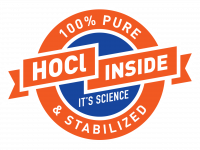HOCl as a Disinfectant
Story At-A-Glance
- Chlorine dissolved in water has been used to safely kill germs since the mid-1800s
- Hypochlorous acid (HOCl) is a byproduct of creating electrolyzed water
- The terms HOCl and acidic electrolyzed water (EW) are used interchangeably in various research articles
Chlorine is a Disinfectant
Using chlorine to kill germs is believed to have been first used in 1847 by a doctor in Europe. In the mid-1800s, it was much safer for a pregnant woman to have her baby delivered at home, or frankly, anywhere but at the hospital. This was true even for the best hospitals in Europe and the U.S.1 If the baby was delivered at home or by a midwife, about 5 out of 1,000 women died during the delivery.2 If instead the delivery occurred at a hospital, the death rate for mothers could be as much as 1 out of every 10 women.3 The cause of death at the hospital was normally “childbed fever,” which was later discovered to be caused by Group A hemolytic streptococcus, a bacteria.4 In 1847, a doctor from Vienna – Dr. Ignaz Semmelweis – thought the disease was somehow spread by the attending physicians to the pregnant women.5 Semmelweis decided to test this theory by encouraging the doctors to wash their hands in a chlorinated lime solution.6 Once this protocol was implemented, the death rate of mothers delivering babies at hospitals significantly dropped.7 Later, it was discovered that chlorine dissolved in water also was effective in killing the streptococcus bacteria.8
Electrolyzed Water as a Disinfectant
Sometime after the 1850s, it was discovered one could create a mix of freely available chlorine compounds by running electricity through a salty, watery solution.9 This solution came to be known as electrolyzed water (EW). EW is classified by its pH characteristic as either strong acid electrolyzed water, weak acid electrolyzed water, slightly acid electrolyzed water, neutralized electrolyzed water, slightly basic electrolyzed water, or strong basic electrolyzed water.10 During the last several decades, many studies have been conducted with the various types of EW to determine their individual germ-killing abilities on various bacteria, fungi, and viruses. Acidic EW has been found to have strong germ-killing ability, and it is now commonly used to kill germs for many applications, particularly in the medical, dental, eye care, personal hygiene, agriculture, and food processing sectors.
HOCl as a Disinfectant
Three chlorine compounds are available in EW, and they include Cl2, HOCl, and OCl–. The concentration of the unreacted chlorine types available in the EW are commonly known as free available chlorine.11 The concentration of each of these chlorine compounds varies depending on the type of EW generated. Various studies have shown that it is the HOCl within the EW which is the most effective of the chlorine compounds at killing germs. One study found that an acidic EW and HOCl solution at identical pH values killed harmful bacteria virtually identically.12 They concluded the ability of acidic EW to kill germs was correlated with the concentration of hypochlorous acid (HOCl) within it.13 Other research has shown acidic EW has a high concentration of HOCl as part of its free available chlorine. As one reads through various research, the terms HOCl and acidic EW are used interchangeably, as it has become widely recognized that it is the high concentration of unreacted HOCl chlorine, within the acidic EW, that is almost exclusively responsible for the solution’s germ-killing effectiveness.14
Future articles will focus on the specific production components, procedures, and protocols used by the best HOCl companies to ensure that the most effective and stable HOCl solutions are produced.
Sources and References
- 1-7 In 1850, Ignaz Semmelweis saved lives with three words: wash your hands, Dr. Howard Markel, May 15, 2015, PBS News Hour
- 8,9,11-14 The Efficiency of Disinfection of Acidic Electrolyzed Water in the Presence of Organic Materials, Toshihiro Oomori, Takumi Oka, Tooru Inuta, and Yoji Arata, Analytical Sciences, April 2000, Vol. 16
- 10 New Clinical Applications of Electrolyzed Water: A Review, Pianpian Yan, Eric Banan-Mwine Daliri, and Deog-Hwan Oh, Microorganisms. 2021 Jan; 9(1): 136.
